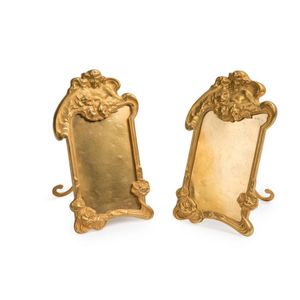Louis XV Giltwood Console Table with Travertine Top
You must be a subscriber, and be logged in to view price and dealer details.
Subscribe Now to view actual auction price for this item
When you subscribe, you have the option of setting the currency in which to display prices to $Au, $US, $NZ or Stg.
- Frieze - An architectural term denoting the flat, shaped or convex horizontal surface of furniture, between the architrave and the cornice, usually found on a cabinet or bookcase, or on desks and tables where it may include drawers, the area between the top and the legs. In ceramics, the term refers to the banding, of usually a repeating pattern, on the rims of plates and vases.
- Stretcher - A horizontal rail which connects the legs of stools, chairs, tables and stands, to provide stabilisation of the legs. A stretcher table is any table with a stretcher base. The term is usually applied to substantial farmhouse tables, although many cabinetmaker's pieces, such as sofa tables, also have turned stretchers.
- Giltwood - Giltwood is used to describe a gold finish on furniture and other decorative wooden items, whereby a thin sheet of gold metal, called gold leaf, is applied to the surface for decorative purposes.
Unlike gilding, where the gold leaf is applied over a coating of gesso, with giltwood the gold leaf is applied direct to the surface, or over a coat of linseed oil gold leaf adhesive.
Most gold-finished mirrors will be gilded, whereas furniture with gold highlights will have the gold applied through the giltwood method. - Foliate - Decorated with leaves or leaf-like forms.
- Composition - Composition is a material used for dolls, sculpture and furniture. It is a type of composite material made from a mixture of materials such as sawdust, glue, and pigments. It is a popular material for dolls and figurines because it is lightweight and easy to work with. It is also used in furniture-making, particularly in the construction of decorative pieces such as figurines and sculptures. It is less common in high-end furniture as it is not as durable as some other materials such as wood or metal. However, it is a more affordable and accessible option for some types of decorative pieces.
This item has been included into following indexes:
Visually similar items

Pair of Florentine giltwood wall brackets, 19th century, each with a moulded serpentine shelf on a carved foliate support (2), height 37 cm width 30 cm

Diamond, opal and enamel brooch / pendant, 14ct yellow gold, of openwork cartouche embellished with black enamel, centring an opal cabochon, featuring seven round brilliant-cut diamonds, stamped '14k, approx. Weight 16.3 grams

A pair of gilt bronze Art Nouveau picture frames, French, circa 1920, 28 x 16 cm

A 14ct gold Cruciform pendant, set with 11 blue sapphires within a scrolling frame, length 35 mm, wt. 3.8g
